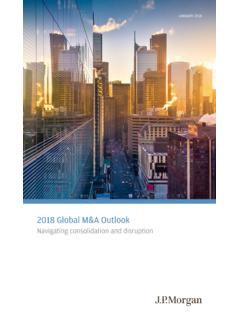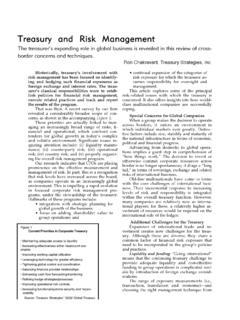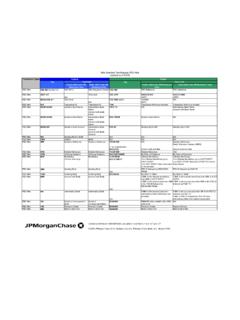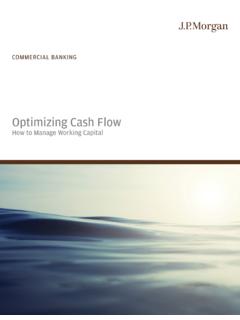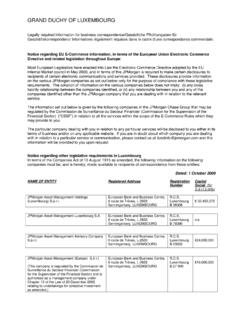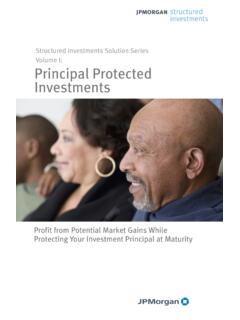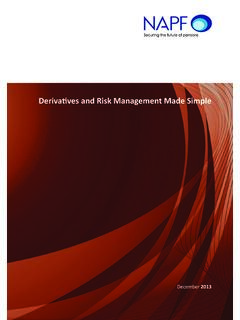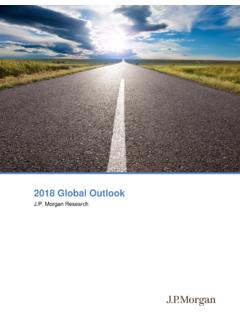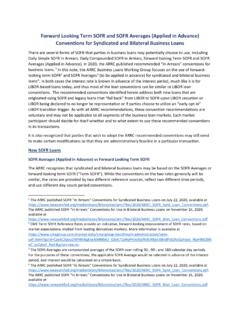Transcription of IBOR Reform Frequently Asked Questions - J.P. Morgan
1 I B O R R e f o r m F r e q u e n t l y A s k e d Q u e s t i o n s June 2021 JUNE 2021 Table of contents 1. Disclaimer .. 1 2. Alternative Reference Rates .. 2 1. Why and when is the London Interbank Offered Rate (LIBOR) ceasing? 2 2. What are Risk Free Rates ( RFRs ) and how are they different from LIBOR? 2 3. How do you calculate a compounded in arrears rate? 3 4. How do I check the amount my company is being charged for interest is correct? 3 5. How have alternative references rates performed during times of volatility? 3 6. Can I move from LIBOR onto another rate other than one of the RFRs? 3 7. Can I move onto a replacement RFR before LIBOR ceases? 4 8. Do bilateral swaps and CSAs need to transition to STR/SOFR discounting, given the Big Bang Discounting and PAI switch at the Central Counterparties (CCPs) in 2020? 5 9. When existing contracts convert from IBOR to an RFR, what happens to the calculation of interest for a period that starts before and ends after an IBOR cessation date?
2 5 3. forward - looking Term Rates .. 6 10. Is there a forward - looking term rate similar to LIBOR? 6 11. I prefer to use a benchmark with a credit sensitive component. Are there any alternatives to a forward - looking Term Rate currently available and are these rates endorsed by National Working Groups? 7 12. Should I use compounded in arrears for loans if term rates become available? 7 4. Contract Fallback Language .. 8 13. What does fallback language mean? 8 14. What will happen if my contracts do not contain fallback language when LIBOR ceases? 8 15. Have any jurisdictions released recommended fallback language for cash products and/or derivatives? 8 16. Have any jurisdictions released recommended fallback language specific to loans? 8 17. Should I change the fallback language in my contracts to reference forward - looking term rates if these become available prior to LIBOR cessation?
3 9 18. What is the solution to address tough legacy contracts in the UK? 9 19. What is the proposed solution to address tough legacy contracts in the US? 9 20. When did the ISDA Protocol launch and take effect? 10 21. What is the difference between pre-cessation and permanent cessation? 10 22. What does trigger or switch mechanism mean in relation to moving to a new RFR? 10 23. Will any other terms in the loan document change as a result of LIBOR transition? 10 5. Credit Spread Adjustment .. 11 24. What is the credit spread adjustment and why is it needed? 11 25. When will the credit spread adjustment be calculated and become active? 11 26. Will there be any basis risk if the credit spread adjustment is not identical between cash products and derivatives? 11 6. Market Liquidity and Portfolio Remediation .. 12 27. Is liquidity for RFRs at tradeable levels for me to transition away from LIBOR?
4 12 28. Can the Firm support us to reduce our existing LIBOR exposure maturing after 2021? 12 29. I have a loan hedged with a derivative: (a) Will the LIBOR transition affect my hedge accounting treatment? (b) Will my derivatives hedges still function as intended upon the cessation of LIBOR? 12 30. Why does my loan document need changing and what options exist if I don t want to change my loan documents? 13 31. I have loans with non-LIBOR benchmark rates. What are the transition timelines for these? 13 32. How will Global Trade products be impacted by LIBOR Reform ? 13 1. Disclaimer does not provide legal, tax, financial or accounting advice and clients should consider any loan amendments and the appropriateness of the fallbacks incorporated therein together with their legal, tax, financial and accounting advisers, taking into consideration their own particular circumstances and the fallbacks that may be applicable in any related products.
5 Please visit the following link for JPMorgan disclosures: 2 2. Alternative Reference Rates 1. Why and when is the London Interbank Offered Rate (LIBOR) ceasing? LIBOR rates are derived from an average of submissions by panel banks. The underlying market that LIBOR seeks to reflect has become increasingly less active. Therefore, given the decrease in transactions, the Financial Stability Board (FSB) has observed that submissions used to determine LIBOR are increasingly based upon expert judgment. In 2017, Andrew Bailey, the Chief Executive of the United Kingdom's Financial Conduct Authority (FCA), which oversees LIBOR, announced that the FCA would no longer persuade or compel member panel banks to make LIBOR quote submissions after 2021 and that market participants should expect LIBOR to be subsequently discontinued, or at least to no longer be deemed representative.
6 On March 5th, the FCA formally announced the cessation of LIBOR following the ICE Benchmark Administration (IBA) s publication of its consultation results. One week USD, two month USD, GBP, EUR, CHF and JPY LIBOR settings will cease following its publication on December 31, 2021. Overnight, one, three, six, and 12 month USD settings will cease after its publication on June 30, 2023. The Federal Reserve Board (FRB), Federal Deposit Insurance Corporation (FDIC), and Office of the Comptroller of the Currency (OCC), issued supervisory guidance encouraging banks to cease entering into new contracts that use USD LIBOR as a reference rate as soon as practicable and in any event by December 31, 2021. New contracts entered into before December 31, 2021 should either utilize a reference rate other than LIBOR or have robust fallback language that includes a clearly defined alternative reference rate after LIBOR s discontinuation.
7 The FCA also welcomed the supervisory guidance issued by the FRB, FDIC, and OCC. 2. What are Risk Free Rates ( RFRs ) and how are they different from LIBOR? Risk Free Rates ( RFRs ) are alternative reference rates that have been developed for use instead of LIBOR. Regulators for the 5 LIBOR currency jurisdictions have published their preferred alternative reference rates as shown in the table below: LIBOR Currency Administrator RFR Secured/ Unsecured USD Federal Reserve Bank of New York (Fed) Secured Overnight Financing Rate (SOFR) Secured GBP Bank of England (BoE) Sterling Overnight Index Average (SONIA) Unsecured EUR European Central Bank (ECB) Euro Short Term Rate ( STR) Unsecured CHF SIX Swiss Exchange Swiss Average Overnight Rate (SARON) Secured YEN Bank of Japan (BoJ) Tokyo Overnight Average Rate (TONA) Unsecured While RFRs and LIBOR are both benchmarks, there are distinct differences between them which include: 1.
8 Reference Period: LIBOR is a forward - looking term rate whereas RFRs are backward- looking overnight rates; 2. Methodology: LIBOR is derived from quotes provided by panel banks submissions that are meant to be estimates of where they could borrow funds whereas RFRs are benchmarks generally based upon a broader range of actual transactions; 3 3. Credit Risk: LIBOR and RFR rates reflect different elements of credit risk. LIBOR is an unsecured borrowing rate and includes the implied credit risk of the panel banks and a liquidity premium related to the length of the interest period. RFRs do not include the panel bank credit risk element nor a liquidity premium related to the length of the interest period as they are overnight rates. Some RFRs are unsecured and others are secured. 3. How do you calculate a compounded in arrears rate? Compounding in arrears is a methodology that compounds daily values of the overnight rate, throughout the relevant term period.
9 Compounding in arrears differs from a typical term rate by calculating interest looking backwards and therefore such a methodology is usually accompanied by a brief period in advance of payment to set the interest rate and calculate payment. The ARRC s A User s Guide to SOFR provides a comprehensive overview of the compatibility of compounded in arrears with SOFR: The SRFRWG published its Recommendation on conventions for referencing compounded in arrears SONIA in the sterling loan market in September 2020 which contains illustrative worked examples of RFR compounding conventions for the Sterling loan market. It also includes a variety of system infrastructure implementation considerations taking into account the overall needs of the sterling loan market and is intended to support the Working Group s target for lenders to be able to offer non-LIBOR alternatives to clients by the end of September.
10 Compounding in arrears is compatible with a wide variety of derivatives and cash products. Please contact your Morgan representative for further information. 4. How do I check the amount my company is being charged for interest is correct? The SRFRWG has published a Freely Available Independent RFR Calculator Summary that includes independent RFR calculators that could be beneficial in helping market participants to calculate and validate interest amounts in agreements for certain RFRs ( SOFR, SONIA, ESTR, TONAR). Users need to independently validate the calculators to ensure that they are accurate. 5. How have alternative references rates performed during times of volatility? The alternative rates are overnight rates and can move around on a daily basis, but they are generally not used in that manner. Contracts referencing the alternative rates are generally based on an average of the daily rates over a longer time period such as 1-month, 3-month, 6-month.
